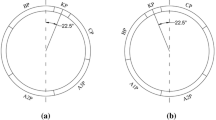Abstract
Experimental stress analysis was performed on design aspects of the loading-face shield not amenable to theoretical analysis. Strain and load data obtained from deflection tests of an aluminum model were used to derive bending-stress coefficients for different sections of the shield; maximum strains were recorded at inner edges of moderator-removal holes. Concrete specimens in which process-tube hole patterns were reproduced were tested in compression; strain-concentration factors as high as eight were recorded. Sleeves of practical proportions were found to be ineffectual in reducing diametric shortening of the holes. Transverse deflections of a plaster scale model were found to be 2 1/2 times greater than predicted by plate theory. On the basis of these investigations, maximum stresses in loading-face-shield concrete and steel were determined and factors of safety were calculated. Results of this analysis indicate that the shield will fulfill service requirements.
Similar content being viewed by others
Abbreviations
- A :
-
cross-section area, in.2
- a :
-
radius (of plate, shield), in.
- b :
-
radius of hole, in.
- d :
-
in-plane deformation, in.
- E :
-
modulus of elasticity, lb/in.2
- I :
-
moment of inertia per unit of width, in.4/ft
- M :
-
bending moment per unit of width, lb-in./ft
- n :
-
ratio of elastic moduli for steel and concrete (=E s /E c , dimensionless)
- w :
-
uniformly distributed load, or pressure, lb/in.2
- t :
-
thickness, in.
- W :
-
weight or load, lb
- X :
-
distance from neutral-axis to compression surface of shield, in.
- δ:
-
transverse deflection, in.
- ε:
-
axial strain, dimensionaless
- λ:
-
bending deflection coefficient (=δEt 3/Wa 2, dimensionless)
- μ:
-
10−6
- ν:
-
Poisson's ratio (dimensionless)
- ξ:
-
bending stress coefficient (=σt 2/W, dimensionless)
- π:
-
a constant (=3.1416, dimensionless)
- σ:
-
stress, lb/in.2
- c :
-
concrete
- e :
-
edge of a central hole
- h :
-
load distributed uniformly around the edge of a hole
- max:
-
maximum value
- s :
-
steel
- t :
-
tangential
- u :
-
uniform surface loading
- 1:
-
model
- 2:
-
loading-face shield
References
Roark, R. J., “Formulas for Stress and Strain,”McGraw-Hill Book Co., Inc., New York (1954).
Davis, H. S., Browne, F. L., and Witter, H. C., “Properties of High-Density Concrete Made with Iron Aggregate,” Jnl. American Concrete Institute (March 1956).
Author information
Authors and Affiliations
Rights and permissions
About this article
Cite this article
Chipman, R.D., Lynch, M.D. & Peterson, R.M. Stress analysis of HNPF loading-face shield. Experimental Mechanics 2, 193–203 (1962). https://doi.org/10.1007/BF02325799
Issue Date:
DOI: https://doi.org/10.1007/BF02325799




